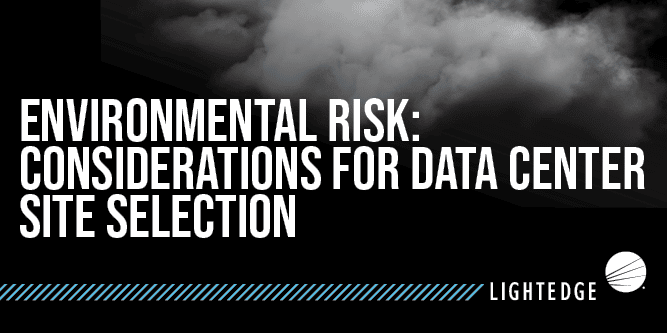How to protect your future data center
When you’re ready to select a partner site for data center colocation and disaster recovery, protection from environmental risks should be the criteria you evaluate first.
Why? While security, bandwidth, uptime and efficiency measures are vital to data center management, Mother Nature is a wild card that has the potential to cause cataclysmic issues for your data center. By refining your geographic preferences first, based on thoughtful consideration of known environmental risk factors, you can streamline your colocation selection process and increase your future data center’s dependability.
Data center natural disaster risks by U.S. region
During your site selection, it is critical to be aware of the natural disasters common to the area. Here are some of the bigger ones that have historically wreaked havoc on data centers and businesses.
Hurricanes
Katrina. Harvey. Sandy. Irma. As major storms over the past few years have deftly illustrated, the power stored in a hurricane unleashed on humanity can have dire consequences for individuals, communities and businesses. A storm is categorized as a hurricane when a tropical cyclone has sustained winds of more than 74 miles per hour. Beyond the tragic loss of life, the astronomical financial impacts paint a picture of vulnerability for data centers located in the hurricane belt.
The financial costs of recent hurricanes according to the NOA:
- Katrina (2005): $125 billion
- Harvey (2017): $125 billion
- Sandy (2012): $65 billion
- Irma (2017): $50 billion
Due to the proximity to the levers of finance, an East Coast data center location for primary servers may be a business requirement. To help mitigate risk to your data, it is recommended to have your disaster recovery or colocation servers in a different geographical zone.
In the United States, hurricanes only happen along the Gulf Coast and Eastern Seaboard. Because we have data centers located in the rolling plains of the Midwest, a colocation site at LightEdge will give you peace-of-mind that your data is far inland from a hurricane disaster area.
Tornados
When you think about Kansas, the first thing that comes to mind might be The Wizard of Oz. But did you know the state with the most tornadoes is actually Texas? The warm, moist air of the Gulf of Mexico combined with the cold air from Canada and the Rocky Mountains, plus the dry warm air of the Sonoran Desert can create the perfect conditions for the formation of tornadoes. “Tornado Alley” as it has been dubbed runs from Texas to Minnesota. When choosing a data center site in this region, it is essential to choose a hardened facility that was designed to withstand at least an F5 tornado.
At LightEdge, our entire Kansas City facility – including all of our infrastructure – is located underground beneath 125 feet of limestone. Our unique location keeps our customer’s servers naturally protected from the impacts that tornadoes could have on other data centers in the area. Even the U.S. Government trusts the security and protection provided by our underground environment. The National Archives are housed in the same system of caves where we’re located!
Earthquakes
While the West Coast of the U.S. may not experience hurricanes, it gets more than its share of earthquakes. For data centers located in seismic zones, “earthquake-proofing” your facility is imperative.
Building codes help protect the human inhabitants of a building and prevent collapse. Seismic design can be incorporated into new and retrofitted buildings in earthquake-prone area to help mitigate the potentially life-threatening effects of earthquakes. Seismic isolation technology has been used successfully in Japan, integrating earthquake gliders into servers in the place of rigid bolting to increase the likelihood servers will survive a seismic event.
Another consideration that many people don’t realize – a common byproduct of severe earthquakes is fire. The warm winds from Southern California can quickly spread fires, where over-stressed fire departments and broken water lines make fighting them a challenge. As a result, mission-critical data on the West Coast should be backed up in regions where earthquake danger low.
Floods
During Hurricane Sandy, back-up generators and fuel stored in the basements of data centers in New Jersey high-rises exposed another data center vulnerability – flooding. While flooding can happen in all 50 states, protecting your colocation from water is an essential evaluation factor in data center site selection. Your data center should be out of the flood plain, away from dams and levees, and located well outside of tsunami zones.
Ice and snow
Ice, which can weigh on trees and break branches, has the potential to cause major power outages that can disrupt your data center. Confirming trees are located away from electric infrastructure is a good practice during site review. Back-up generators should also be housed in an environment protected from ice and snow to ensure dependable redundancy. For above-ground facilities, the weight of snow is a data center threat due to its potential to cause roof collapse. Just 24 inches of snow can weigh 17 pounds per square foot. So, a roof the size of a football field (300 feet x 150 feet) could have 765,000 pounds of snow on it after a 24-inch accumulation. For comparison, with the average U.S. car weighing in at about 4,000 pounds, that would be the equivalent of 190 cars parked on the roof!
When selecting a site for your colocation, it’s important to do your homework. Start your site selection process by evaluating major environmental risks that could impact your data center’s dependability.




